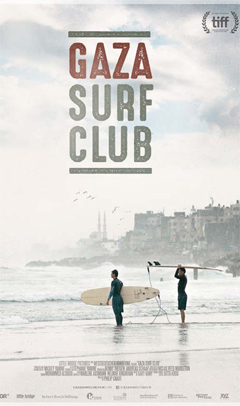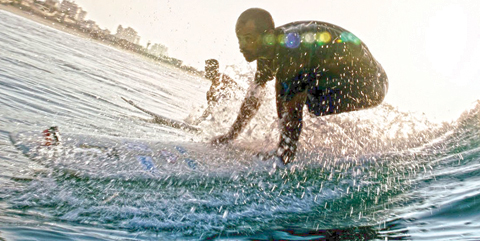 Audiences everywhere will be embracing "Gaza Surf Club," an inspiring, warmhearted look at a group of resilient spirits who find a way to indulge their passion for surfing while living in the Gaza Strip, one of the world's most battle-scarred locales. Directors Philip Gnadt and Mickey Yamine focus most on two people: a 23-year-old man dreaming of training in Hawaii, and a teenage girl whose journey to adulthood means having to give up life in the waves. While all the expected surfer pic shots are included, this isn't a documentary for the usual aficionados but a spirited and moving profile of an informal, independent group finding escape via that most free-spirited of sports. The film's release in Germany in early 2017 is likely to prefigure a wider international rollout.
Audiences everywhere will be embracing "Gaza Surf Club," an inspiring, warmhearted look at a group of resilient spirits who find a way to indulge their passion for surfing while living in the Gaza Strip, one of the world's most battle-scarred locales. Directors Philip Gnadt and Mickey Yamine focus most on two people: a 23-year-old man dreaming of training in Hawaii, and a teenage girl whose journey to adulthood means having to give up life in the waves. While all the expected surfer pic shots are included, this isn't a documentary for the usual aficionados but a spirited and moving profile of an informal, independent group finding escape via that most free-spirited of sports. The film's release in Germany in early 2017 is likely to prefigure a wider international rollout.
Strangled by Israel and ruled by the fundamentalist organization Hamas, the Gaza Strip has become an embodiment of misery, its tightly-packed population trapped between relentless Israeli assaults and a strictly controlled seafront. It's not a place one expects to find surfers, but for years a group of men - and some girls - have looked to riding the waves as their only form of mental escape. Using rough, homemade boards and precious professional ones brought in by groups such as Surfing 4 Peace, these determined nonconformists find relief from the hopelessness of their situation in the Mediterranean's waves.
Ibrahim Arafat, 23 at the film's end, would fit in anywhere that fellow board-worshippers congregate. Mentored by Matthew Olsen, an American who helped connect the Gaza surfers to the international community through his organization Explore Corps, Ibrahim resists family pressure to become a fisherman, instead dreaming of going to Hawaii to intern with board makers. Visas however are extremely difficult to come by for Palestinians in the Gaza Strip, and he's already been rejected five times.
Sabah Abu Ghanem, 15, faces a different problem. Before puberty, her father, Rajab, taught her to surf, and she adored the feeling of freedom. But Hamas enforces a conservative interpretation of Islam, and now that she wears a hijab, she can only look longingly at the sea since even bathing can be considered immodest. Trapped not only by politics but religion as well, Sabah embodies the frustration of dreams by the regime's rigid application of fundamentalist constraints. For Ibrahim at least, good news breaks through the clouds of oppression, and his visa application is accepted. It's a thrilling moment, with the directors following him on his journey from bombed-out lots and constant uncertainty to the surfing paradise of Hawaii, which unsurprisingly leads to a high degree of culture shock that the documentary only briefly touches upon. What has happened since the cameras stopped rolling is left deliberately hanging in the air, and there are sure to be scads of Google hits as viewers try to learn more about Ibrahim and Sabah. The film's widescreen visuals nicely capture the thrill of the waves and the sense of the beach as a haven from the prison-like existence that characterizes the Gaza Strip.-Reuters











